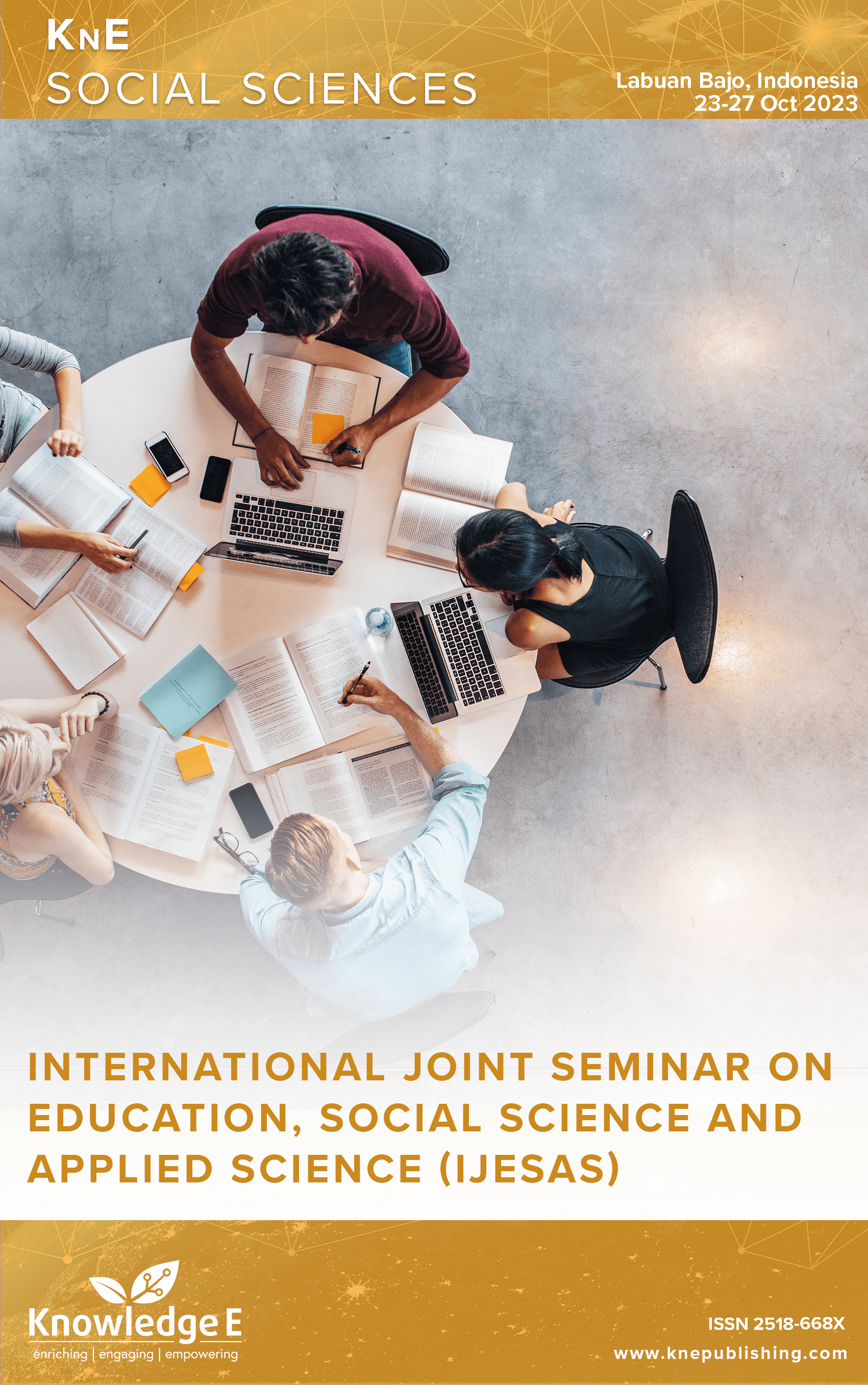Students' Cultural Literacy Development through Dialogical Approach in Senior High School
DOI:
https://doi.org/10.18502/kss.v9i19.16507Abstract
The aim of this study is to evaluate the efficacy of the dialogical approach in developing students’ cultural literacy in senior high school. A quasi-experiment method with a non-equivalent control group design was employed in this research, with an experimental class and a control class. Descriptive analysis and prerequisite tests, such as homogeneity and normality tests, were used in this study’s data analysis techniques. Additionally, the Independent Sample T-Test and N-Gain data analysis were used to test hypotheses. The findings of this study demonstrate that implementing the dialogical approach can significantly enhance students’ cultural literacy, with a notable difference in efficacy between the experimental and control groups in second-grade students of senior high school. The study’s findings are worldwide diversity character data gathered using 30-item questionnaire as a research tool. After receiving the treatment, the average posttest findings demonstrate that students’ understanding of global variety has improved, particularly in the experimental group. The average posttest score for the experimental class was 91.46, whereas the control class’s score was 71.37. This indicates that the experimental class’s posttest score was higher than the control class’s. This demonstrates that the experimental class’s worldwide variety is greater than the control class’s. The practical implication of students’ cultural literacy in the classroom and school environment is the ability to understand and accept differences in cultural diversity backgrounds among them. Thus, the nation’s integrity and unity can be achieved according to the ideals of the state. Of course, the authors have limitations in this study.Therefore, in the future, input and further research are needed in order to perfect the results of previous research results.
Keywords: cultural Literacy, dialogical Approach, students development skill
References
Başöz T. Exploring the relationship between tolerance of ambiguity of EFL learners and their vocabulary knowledge. Journal of Language and Linguistic Studies. 2015;11(2):53–66.
Shlomit IB. Abeer Watted, ‘Cultural Background in Digital Literacy of elementry and middle school students: Self-Appraisal versus actual performabce’. J Comput Assist Learn. 2023;:1591–605. DOI: https://doi.org/10.1111/jcal.12820
Cook V, Maine F, Čermáková A. Enacting cultural literacy as a dialogic social practice: the role of provisional language in classroom talk. Lond Rev Educ. 2022;20(1):1–13. DOI: https://doi.org/10.14324/LRE.20.1.02
Bal M, Mete F. Cultural literacy in mother tongue education: an action research. Qualitative Research in Education. 2019;8(2):215–44. DOI: https://doi.org/10.17583/qre.2019.4186
Garcia-Mila M, Miralda-Banda A, Luna J, Remesal A, Castells N, Gilabert S. ‘Change in classroom dialogicity to promote cultural literacy across educational levels’, Sustainability (Switzerland). vol. 13, no. 11, p. 2021. https://doi.org/10.3390/su13116410. DOI: https://doi.org/10.3390/su13116410
Crist E, Popa D. ‘Information literacy and cultural context: chinese english language learners’ understandings of information authority’. Coll Res Libr. 2020;81(4):646–61. DOI: https://doi.org/10.5860/crl.81.4.646
Maryl M. ‘Cultural Literacy: An Outline of Total Research into Literary Culture’, p. 2016.
Segal N. From Literature to Cultural Literacy. Humanities (Washington). 2015;4(1):68– 79. DOI: https://doi.org/10.3390/h4010068
Efthymiou A, Kalaitzaki A, Rovithis M. ‘Cultural Adaptation of a Health Literacy Toolkit for Healthcare Professionals Working in the Primary Care Setting with Older Adults’, Healthcare (Switzerland). vol. 11, no. 5, p. 2023. https://doi.org/10.3390/healthcare11050776. DOI: https://doi.org/10.3390/healthcare11050776
Naqeeb H. Promoting cultural literacy in the EFL classroom. Global Advanced Research Journal of Educational Research and Reviews. 2012;1(4):41–6.
García Ochoa G, McDonald S. Destabilisation and cultural literacy. Intercult Educ. 2019;30(4):351–67. DOI: https://doi.org/10.1080/14675986.2018.1540112
Crawshaw R. Beyond Emotion: Empathy, Social Contagion and Cultural Literacy. Open Cult Stud. 2018;2(1):676–85. DOI: https://doi.org/10.1515/culture-2018-0061
Rutten K. ‘Cultural Literacy in Transition’, Routledge, Taylor & Francis Group. pp. 1–7, 2020. https://doi.org/10.1080/02560046.2020.1840849. DOI: https://doi.org/10.1080/02560046.2020.1840849
B.L. Iverson and P.B. Dervan, ‘The DIALLS platform: supporting cultural literacy and understanding of European values over the intenet’,. pp. 7823–7830,.
Ursa A. Storybooks as a Way to Improve Language and Cultural Literacy. Philologica Jassyensia. 2018;14(1):255–65.
Zhao R, Lu D. Repertoire Construction for Critical Cross-Cultural Literacy of English Majors: Based on the Research Paradigm of Systemic Functional Linguistics. Front Psychol. 2022 Jun;13( June):906175. DOI: https://doi.org/10.3389/fpsyg.2022.906175
Callander D. Dialogic Approaches to Teaching and Learning in the Primary Grades. 2013. pp. 1–122.
T. Lähdesmäki, J. Baranova, S.C. Ylönen, et al., Learning Cultural Literacy through Creative Practices in Schools: Cultural and Multimodal Approaches to Meaning- Making., 2021. DOI: https://doi.org/10.1007/978-3-030-89236-4
Akkerman SF, Meijer PC. A dialogical approach to conceptualizing teacher identity. Teach Teach Educ. 2011;27(2):308–19. DOI: https://doi.org/10.1016/j.tate.2010.08.013
Ochoa GG, McDonald S, Monk N. Adapting Open-space Learning Techniques to Teach Cultural Literacy. Open Cult Stud. 2018;2(1):510–9. DOI: https://doi.org/10.1515/culture-2018-0046
J.H.& A. Harris, ‘The Geanology of Cultural Literacy’,. Routledge, Taylor & Francis Group. pp. 383–395, 2022.
Rathnayake S, Liyanage IP. Cross-cultural adaptation and psychometric properties of the Sinhala version of electronic health literacy scale: A cross-sectional validation study. PLoS One. 2022 Apr;17(4):e0266515. DOI: https://doi.org/10.1371/journal.pone.0266515
Si RK. ‘ilata, M.M. Jacobs, J.S. Gaffney, M. Aseta, and K. Hansell, ’Making Space for Young Children’s Embodied Cultural Literacies and Heritage Languages with Dual Language Books’. Read Teach. 2023;77(1):24–36. DOI: https://doi.org/10.1002/trtr.2195
Aalberg T, Strabac Z, Brekken T. ‘Research Design’, How Media Inform Democracy: A Comparative Approach. pp. 15–30, 2012. DOI: https://doi.org/10.4324/9780203803448
Kobakhidze G. Theoretical background for A sтвaтecy of development of cultural literacy in schools. Journal of Education Culture and Society. 2021;12(1):45–58. DOI: https://doi.org/10.15503/jecs2021.1.45.58
Yuriananta R, Suyitno I, Basuki IA, Susanto G. the Development of Cultural Literacy for Indonesian for Foreign Speakers (Bipa) Students Through Rpg Games With a Gamification Approach. Revista de Gestao Social e Ambiental. 2023;17(4):1–11. DOI: https://doi.org/10.24857/rgsa.v17n4-019
Knudsen JS. Arts for Children, Cultural Diversity and the Production of Difference. Nordic Journal of Art and Research. 2021;10(2):1–15. DOI: https://doi.org/10.7577/information.3998
Kartono DT, Zuber A, Budi AC, Wilujeng PR. Identity and Socio-cultural Crisis in Industrial Cities: A Study on Workers in Jakarta and Makassar, Indonesia. Society. 2023;11(1):95–105. DOI: https://doi.org/10.33019/society.v11i1.440
Kim HS, Drolet A. Choice and self-expression: a cultural analysis of variety-seeking. J Pers Soc Psychol. 2003 Aug;85(2):373–82. DOI: https://doi.org/10.1037/0022-3514.85.2.373
T. Akib, M. Wajdi, M. Natsir, E. Hasan, and Abidin, ‘Digital Literacy and Teaching Creativity of Educators in Learning Activities: A Survey Method Review’. Indonesian Journal of Research and Educational Review. 2022;1(3):278–85. DOI: https://doi.org/10.51574/ijrer.v1i3.267

